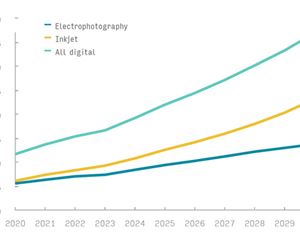Printing India’s next chapter in book publishing — The Noel D’Cunha Sunday Column
At the PrintWeek–HP–Redington knowledge webinar, four speakers - Anthony Paguirigan, Yoav Lotan, Ashok Pahwa and Amit Sharma - examined the scale, challenges and opportunities of India’s publishing sector. A closer look at what transpired...
22 Aug 2025 | By Noel D'Cunha
When the discussion opened on the future of books in India, the mood was clear. The demand is there, the ambition is there, and the challenges are plenty. Education, literacy and languages sit at the core, but execution is what will shape the industry’s future. What emerged in the conversation was a view of publishing as a complex ecosystem, where policy, technology and industry mastery must converge.
Sriraam Selvam, moderating the webinar for PrintWeek, begins by observing that the Indian publishing and printing landscape is undergoing a profound shift in demand. “The Indian publishing and printing sector is experiencing significant changes in demand, particularly in the K12 segment. While this area has historically been large, it is now marked by heightened expectations for speed and efficiency. Print service providers face pressure to meet volume needs within shorter cycles, aligning with changing academic calendars and rapid syllabus updates,” Selvam emphasises.
Language diversity adds another layer of complexity, with over 22 official languages requiring unique scripts and typesettings. This increases the matrix of products, challenging printers who must manage quality control carefully to avoid costly mistakes. However, localisation presents opportunities for publishers to tap into broader markets.
The rise of regional publishing is also noteworthy. Smaller towns now demand quality materials comparable to those in metropolitan areas, driven by increased literacy and educational programs. This shift values agility over scale, with printers producing smaller runs across diverse titles.
Market growth remains robust
Anthony Paguirigan, category manager at HP PageWide Industrial, sets the frame with hard data. “Revenue in the book market is projected to reach USD 5.83-billion in 2025,” he says. Of this, USD 5.13-billion comes from physical books, USD 440-million from audiobooks, and USD 260- million from eBooks. Growth is expected to continue at 3% annually, reaching USD 6.78-billion by 2030. By then, the physical book market will have 442.6-million readers, with a penetration rate above 54%. As Paguirigan adds, “The physical book will continue to dominate the Indian book market.”
The audience takes note because this is not just a number but a reminder of where the business sits. Even as digital formats rise, the backbone is still ink on paper. India’s demographics, with a young population and expanding literacy, create structural demand. The numbers validate what publishers and printers see on the ground: orders for textbooks, competitive exam guides, and regional language titles remain high.
Yoav Lotan, manager of APJ products and solutions at HP Industrial Print, stresses that this expansion is not just about quantity. “Publishers want more predictability,” he notes. Shorter runs, faster replenishment, and the ability to balance inventory without locking capital are shaping decisions. The digital-analogue balance is becoming a survival strategy, not a luxury.
Lotan’s point connects to a theme that runs across the session. Technology is not only about replacing presses but about enabling models that match the economics of publishing. A 3% growth rate may sound steady, but the composition of that growth, especially the resilience of physical books, creates pressure on supply chains. Printers must align with this complexity or risk being left behind.
Paguirigan reinforces the urgency with another observation. “Penetration is climbing, but it is uneven,” he explains. Urban readers are adopting audiobooks and eBooks faster, while rural markets still rely almost entirely on printed books. This duality complicates strategy. Publishers cannot ignore the digital shift, but neither can they neglect the continuing dominance of print.
The implication is clear. Print is not in decline; it is diversifying. Success depends on reading the numbers correctly and responding with agility. The scale of India’s market ensures demand, but the winners will be those who align with its structural shape.
Technology enables flexible printing
Lotan drills down on technology’s role in managing this complexity. “Flexibility is not an option; it is a necessity,” he explains. Digital print platforms enable publishers to print 500 copies today and 5,000 copies tomorrow, eliminating the friction of plates and extended setup. This responsiveness matches the erratic rhythm of orders in education and trade publishing.
Selvam picks up the thread from a practitioner’s perspective. He describes how Indian printers are adapting to the needs of publishers who want to print in multiple languages and formats simultaneously. “The challenge is not just to print more but to print smarter,” he notes. Machines alone cannot solve the problem unless processes align with the demand for rapid turnaround and versioning.
Ashok Pahwa, business manager, HP Indigo and PWI commercial, Indian Subcontinent market, HP Industrial Print, contextualises this with a broader vision. “Technology is about reducing unpredictability,” he says. A school order delayed by weeks can disrupt academic cycles, while an exam guide delivered late can lose its entire relevance. Digital presses, with their ability to deliver on demand, reduce these risks. But he also warns against assuming technology adoption is straightforward. Printers must invest in training, integration, and financial models that make the transition sustainable.
Lotan illustrates with an example. In one case, a publisher faced recurring shortages of a popular textbook mid-semester. Traditional offset economics discouraged small replenishment runs. With digital capacity, the printer could top up 1,000 copies within days, ensuring continuity. “This is where flexibility becomes a competitive advantage,” Lotan explains.
The conversation makes a distinction between hype and application. Digital print is not about replacing offset for every job. It is about creating an elastic layer in the supply chain that absorbs shocks and aligns production with real demand. For India, with its fragmented market and linguistic diversity, this capability is critical.
Data shapes smarter decisions
Another consistent theme is data. Paguirigan highlights that “publishers and printers already have data; the question is whether they use it.” Metrics such as spoilage, downtime, and throughput often remain buried in job records but can unlock efficiency if analysed systematically.
Selvam explains how some Indian printers are starting to use dashboards that track order patterns across regions and languages. “When you can see demand clustering in one zone, you can plan stock more effectively,” he says. This reduces both wastage and missed opportunities.
Pahwa echoes this from HP’s vantage point. “Automation without data discipline is risky,” he cautions. Installing a new press may create speed, but unless printers know which titles are profitable at which run lengths, they risk misusing capacity. He urges the industry to view data as part of the production chain, not as a side tool.
Lotan adds that data is not only operational but strategic. By examining which titles need frequent replenishment, publishers can adjust licensing strategies, negotiate better with distributors, and even design new product lines. “It is no longer just print management; it is market intelligence,” he states.
Paguirigan cites global benchmarks to show what is possible. In some markets, publishers predict replenishment needs with 90% accuracy using analytics. For India, with its complexity, achieving even 70% would transform efficiency.
The message is clear. Printers must shift from reactive problem-solving to predictive decision-making. Data is the lever, and the tools already exist. What is needed is the will to use them consistently.
Efficiency defines profit margins
Selvam makes a blunt point: “Margins are thin, and one percentage point can decide survival.” Efficiency, therefore, is not a side concern but the core of profitability. He stresses that Indian printers often pride themselves on their ability to deliver under pressure, but this firefighting culture comes at a cost.
Paguirigan connects this to global dynamics. “Publishers everywhere are under pressure to reduce the cost of goods,” he notes. In India, where book prices are among the lowest in the world, the impact is sharper. Efficiency in setup, scheduling, and binding becomes the make-or-break factor.
Lotan illustrates with an example. A printer that failed to slot jobs intelligently across languages ended up with multiple machine stoppages. The same workload, managed with disciplined scheduling, could have saved 12% in operating hours. “Efficiency is design, not luck,” he observes.
Pahwa stresses the role of workforce skill in this equation. “Even the best machine underperforms without skilled operators,” he explains. Training and incentives can elevate operators from task executors to process managers. He points to examples where printers who invested in upskilling achieved higher utilisation of existing presses than competitors who simply bought new ones.
The link between efficiency and resilience also surfaces. Vendors, from paper suppliers to logistics partners, form part of the chain. Selvam argues that printers who cultivate strong vendor relationships are better able to manage volatility. “A sudden paper price hike or transport strike can cripple operations if you have no contingencies,” he says.
Ultimately, efficiency is about discipline. It demands system thinking, not just quick fixes. The Indian industry has shown it can deliver under pressure. The next step is to embed efficiency so that pressure does not define performance.
Scale meets local complexity
Paguirigan highlights another paradox in the Indian context: scale and complexity co-exist. “You are looking at one of the largest markets in the world,” he says, “but it is fragmented into languages, curricula, and regional demands.” Meeting this requires both capacity and flexibility.
Lotan describes this as the “many Indias” problem. A publisher cannot treat the market as a single unit. A mathematics textbook in Hindi and English may share content but requires separate production runs, distribution networks, and timelines. This multiplies complexity without adding proportionate scale benefits.
Pahwa observes that technology adoption must recognise this fragmentation. A press investment must make sense across multiple SKUs, not just a single high-volume line. “Printers who ignore this risk underutilisation,” he cautions.
Selvam notes that some firms are experimenting with hybrid models. For core titles, they use offset for scale; for secondary titles, they rely on digital for responsiveness. This combination allows them to serve the “long tail” without inflating costs.
The panel agrees that mastering this balance is not easy but is central to future competitiveness. Scale gives leverage, but only if it is matched with systems that manage local variation.
Publishers demand reliability first
Lotan brings the publisher’s voice into the discussion. “What they want above all is reliability,” he explains. Price matters, but the assurance that books will reach markets on time is non-negotiable. In educational publishing, delays erode trust rapidly.
Paguirigan reinforces this with figures. In the Indian market, lost sales from delayed textbooks can run into millions of dollars annually. “The damage is not just financial,” he says, “it is reputational.” Schools and parents remember which publishers failed to deliver.
Selvam adds that publishers are not only looking for print vendors but for supply chain partners. Printers who can offer warehousing, distribution integration, and rapid replenishment win more contracts. “It is no longer just about who has the cheapest press hour,” he notes.
Pahwa explains that this shift requires a cultural change among printers. Instead of selling print capacity, they must position themselves as part of the publisher’s workflow. “Reliability is about embedding yourself in the system, not just delivering a product,” he says.
Examples illustrate the point. A printer who integrated ERP with a publisher’s ordering system could trigger production automatically when stock fell below a threshold. This eliminated delays and made the printer indispensable. The lesson is clear. Reliability is now the differentiator. For printers, this means thinking beyond presses and aligning with the full publishing process.
Partnerships build industry resilience
The conversation also highlights partnerships as a survival tool. Paguirigan notes that publishers, printers, and technology providers cannot solve challenges in isolation. “Collaboration is no longer optional,” he states.
Lotan gives the example of HP working with local partners to design presses that suit Indian conditions. Heat, dust, and variable power supply create challenges that cannot be solved with generic global models. “Localisation through partnership makes technology adoption viable,” he explains.
Selvam expands on this with the role of consortia. In some states, smaller printers pool capacity to serve large government textbook orders. This model spreads risk and builds collective capability. “It is not always about competition; sometimes survival depends on collaboration,” he says.
Pahwa adds that partnerships extend to workforce development. Joint training programmes between publishers and printers can ensure that operators understand not only how to run machines but also the context of publishing cycles. “Shared understanding improves execution,” he explains.
These examples show that partnerships are not abstract ideals but practical mechanisms to manage volatility. In a market as large and fragmented as India’s, resilience depends on shared capability.
Future outlook requires adaptation
The session closes with a forward-looking note. Paguirigan summarises: “The numbers show growth, but the shape of that growth demands adaptation.” The market is expanding, but unevenly, and only those who align with its structure will benefit.
Lotan stresses that the future will not be defined by one technology or model. “It will be hybrid, flexible, and data-driven,” he says. Printers must prepare for constant adjustment rather than stable formulas. Selvam adds that the cultural shift is as important as the technical one. Printers must shift their focus from pride in firefighting to pride in mastery. “The industry can deliver under pressure; now it must deliver without pressure,” he explains.
Pahwa closes with a reminder that opportunity and risk are intertwined. India’s growth story is compelling, but only those who integrate smart processes, technology, and partnerships will convert potential into performance.
The message is consistent. Demand is assured, but execution will define the winners. India’s book publishing and printing industry stands at a crossroads. Scale, complexity, and resilience will shape its trajectory. Those who combine adaptability with mastery will not just survive but lead the next phase of growth.












 See All
See All